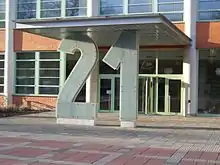21 (number)
21 (twenty-one) is the natural number following 20 and preceding 22.
| ||||
|---|---|---|---|---|
[[{{#expr: (floor({{{number}}} div {{{factor}}})) * {{{factor}}}+({{{1}}}*{{{factor}}} div 10)}} (number)|{{#switch:{{{1}}}|-1={{#ifexpr:(floor({{{number}}} div 10)) = 0|-1|←}}|10=→|#default={{#expr:(floor({{{number}}} div {{{factor}}})) * {{{factor}}}+({{{1}}}*{{{factor}}} div 10)}}}}]] [[{{#expr: (floor({{{number}}} div {{{factor}}})) * {{{factor}}}+({{{1}}}*{{{factor}}} div 10)}} (number)|{{#switch:{{{1}}}|-1={{#ifexpr:(floor({{{number}}} div 10)) = 0|-1|←}}|10=→|#default={{#expr:(floor({{{number}}} div {{{factor}}})) * {{{factor}}}+({{{1}}}*{{{factor}}} div 10)}}}}]] [[{{#expr: (floor({{{number}}} div {{{factor}}})) * {{{factor}}}+({{{1}}}*{{{factor}}} div 10)}} (number)|{{#switch:{{{1}}}|-1={{#ifexpr:(floor({{{number}}} div 10)) = 0|-1|←}}|10=→|#default={{#expr:(floor({{{number}}} div {{{factor}}})) * {{{factor}}}+({{{1}}}*{{{factor}}} div 10)}}}}]] [[{{#expr: (floor({{{number}}} div {{{factor}}})) * {{{factor}}}+({{{1}}}*{{{factor}}} div 10)}} (number)|{{#switch:{{{1}}}|-1={{#ifexpr:(floor({{{number}}} div 10)) = 0|-1|←}}|10=→|#default={{#expr:(floor({{{number}}} div {{{factor}}})) * {{{factor}}}+({{{1}}}*{{{factor}}} div 10)}}}}]] [[{{#expr: (floor({{{number}}} div {{{factor}}})) * {{{factor}}}+({{{1}}}*{{{factor}}} div 10)}} (number)|{{#switch:{{{1}}}|-1={{#ifexpr:(floor({{{number}}} div 10)) = 0|-1|←}}|10=→|#default={{#expr:(floor({{{number}}} div {{{factor}}})) * {{{factor}}}+({{{1}}}*{{{factor}}} div 10)}}}}]] [[{{#expr: (floor({{{number}}} div {{{factor}}})) * {{{factor}}}+({{{1}}}*{{{factor}}} div 10)}} (number)|{{#switch:{{{1}}}|-1={{#ifexpr:(floor({{{number}}} div 10)) = 0|-1|←}}|10=→|#default={{#expr:(floor({{{number}}} div {{{factor}}})) * {{{factor}}}+({{{1}}}*{{{factor}}} div 10)}}}}]] [[{{#expr: (floor({{{number}}} div {{{factor}}})) * {{{factor}}}+({{{1}}}*{{{factor}}} div 10)}} (number)|{{#switch:{{{1}}}|-1={{#ifexpr:(floor({{{number}}} div 10)) = 0|-1|←}}|10=→|#default={{#expr:(floor({{{number}}} div {{{factor}}})) * {{{factor}}}+({{{1}}}*{{{factor}}} div 10)}}}}]] [[{{#expr: (floor({{{number}}} div {{{factor}}})) * {{{factor}}}+({{{1}}}*{{{factor}}} div 10)}} (number)|{{#switch:{{{1}}}|-1={{#ifexpr:(floor({{{number}}} div 10)) = 0|-1|←}}|10=→|#default={{#expr:(floor({{{number}}} div {{{factor}}})) * {{{factor}}}+({{{1}}}*{{{factor}}} div 10)}}}}]] [[{{#expr: (floor({{{number}}} div {{{factor}}})) * {{{factor}}}+({{{1}}}*{{{factor}}} div 10)}} (number)|{{#switch:{{{1}}}|-1={{#ifexpr:(floor({{{number}}} div 10)) = 0|-1|←}}|10=→|#default={{#expr:(floor({{{number}}} div {{{factor}}})) * {{{factor}}}+({{{1}}}*{{{factor}}} div 10)}}}}]] [[{{#expr: (floor({{{number}}} div {{{factor}}})) * {{{factor}}}+({{{1}}}*{{{factor}}} div 10)}} (number)|{{#switch:{{{1}}}|-1={{#ifexpr:(floor({{{number}}} div 10)) = 0|-1|←}}|10=→|#default={{#expr:(floor({{{number}}} div {{{factor}}})) * {{{factor}}}+({{{1}}}*{{{factor}}} div 10)}}}}]] [[{{#expr: (floor({{{number}}} div {{{factor}}})) * {{{factor}}}+({{{1}}}*{{{factor}}} div 10)}} (number)|{{#switch:{{{1}}}|-1={{#ifexpr:(floor({{{number}}} div 10)) = 0|-1|←}}|10=→|#default={{#expr:(floor({{{number}}} div {{{factor}}})) * {{{factor}}}+({{{1}}}*{{{factor}}} div 10)}}}}]] [[{{#expr: (floor({{{number}}} div {{{factor}}})) * {{{factor}}}+({{{1}}}*{{{factor}}} div 10)}} (number)|{{#switch:{{{1}}}|-1={{#ifexpr:(floor({{{number}}} div 10)) = 0|-1|←}}|10=→|#default={{#expr:(floor({{{number}}} div {{{factor}}})) * {{{factor}}}+({{{1}}}*{{{factor}}} div 10)}}}}]] | ||||
| Cardinal | twenty-one | |||
| Ordinal | 21st (twenty-first) | |||
| Factorization | 3 × 7 | |||
| Divisors | 1, 3, 7, 21 | |||
| Greek numeral | ΚΑ´ | |||
| Roman numeral | XXI | |||
| Binary | 101012 | |||
| Ternary | 2103 | |||
| Octal | 258 | |||
| Duodecimal | 1912 | |||
| Hexadecimal | 1516 | |||
In mathematics
21 is:
- a Blum integer, since it is a semiprime with both its prime factors being Gaussian primes.[1]
- a Fibonacci number.[2]
- a Harshad number.[3]
- a Motzkin number.[4]
- a triangular number,[5] because it is the sum of the first six natural numbers (1 + 2 + 3 + 4 + 5 + 6 = 21).
- an octagonal number.[6]
- a composite number, its proper divisors being 1, 3 and 7.
- the sum of the divisors of the first 5 positive integers (i.e., 1 + (1 + 2) + (1 + 3) + (1 + 2 + 4) + (1 + 5))
- the smallest non-trivial example of a Fibonacci number whose digits are Fibonacci numbers and whose digit sum is also a Fibonacci number.
- a repdigit in base 4 (1114).
- the smallest natural number that is not close to a power of 2, 2n, where the range of closeness is ±n.
- the smallest number of differently sized squares needed to square the square.[7]
- the largest n with this property: for any positive integers a,b such that a + b = n, at least one of and is a terminating decimal. See a brief proof below.
|
Note that a necessary condition for n is that for any a coprime to n, a and n - a must satisfy the condition above, therefore at least one of a and n - a must only have factor 2 and 5. Let denote the quantity of the numbers smaller than n that only have factor 2 and 5 and that are coprime to n, we instantly have . We can easily see that for sufficiently large n, , but , as n goes to infinity, thus fails to hold for sufficiently large n. In fact, For every n > 2, we have and so fails to hold when n > 273 (actually, when n > 33). Just check a few numbers to see that n = 2, 3, 4, 5, 6, 7, 8, 9, 11, 12, 15, 21. |
21 appears in the Padovan sequence, preceded by the terms 9, 12, 16 (it is the sum of the first two of these).[8]
| Look up twenty-one in Wiktionary, the free dictionary. |
In science
- The atomic number of scandium.
- It is very often the day of the solstices in both June and December, though the precise date varies by year.
Age 21
- In thirteen countries, 21 is the age of majority. See also: Coming of age.
- In eight countries, 21 is the minimum age to purchase tobacco products.
- In seventeen countries, 21 is the drinking age.
- In nine countries, it is the voting age.
- In most US states, 21 is the minimum age at which a person may gamble or enter casinos.
- In the United States, 21 is the minimum age to purchase a handgun or handgun ammunition.
- In the United States, 21 is the age at which one can purchase multiple tickets to an R-rated film without providing identification.
- In some countries, 21 is the minimum age to accompany a learner driver, provided that the person supervising the learner has held a full driver license for a specified amount of time. See also: List of minimum driving ages.
In sports
- Twenty-one is a variation of street basketball, in which each player, of which there can be any number, plays for himself only (i.e. not part of a team); the name comes from the requisite number of baskets.
- In three-on-three basketball games held under FIBA rules, branded as 3x3, the game ends by rule once either team has reached 21 points.
- In badminton, and table tennis (before 2001), 21 points are required to win a game.
- In AFL Women's, the top-level league of women's Australian rules football, each team is allowed a squad of 21 players (16 on the field and five interchanges).
In other fields


21 is:
- The Twenty-first Amendment repealed the Eighteenth Amendment, thereby ending Prohibition.
- The number of spots on a standard cubical (six-sided) die (1+2+3+4+5+6)
- The number of firings in a 21-gun salute honoring Royalty or leaders of countries
- "Twenty One", a 1994 song by an Irish rock band The Cranberries
- "21 Guns", a 2009 song by the punk-rock band Green Day
- Twenty One Pilots, an American musical duo
- There are 21 trump cards of the tarot deck if one does not consider The Fool to be a proper trump card.
- The standard TCP/IP port number for FTP connection
- The Twenty-One Demands were a set of demands which were sent to the Chinese government by the Japanese government of Okuma Shigenobu in 1915
- 21 Demands of MKS led to the foundation of Solidarity in Poland.
- In Israel, the number is associated with the profile 21 (the military profile designation granting an exemption from the military service)
- Duncan MacDougall reported that 21 grams is the weight of the soul, according to an experiment.
- The number of the French department Côte-d'Or
- Twenty-One (card game), an ancient card game in which the key value and highest-winning point total is 21
- Blackjack, a modern version of Twenty-One played in casinos
- The number of shillings in a guinea.
- The number of solar rays in the flag of Kurdistan.
- Twenty-One, an American game show that became the center of the 1950s quiz show scandals when it was shown to be rigged.
- The number on the logo for the American game show Catch 21
References
| Wikimedia Commons has media related to 21 (number). |
- "Sloane's A016105 : Blum integers". The On-Line Encyclopedia of Integer Sequences. OEIS Foundation. Retrieved 2016-05-31.
- "Sloane's A000045 : Fibonacci numbers". The On-Line Encyclopedia of Integer Sequences. OEIS Foundation. Retrieved 2016-05-31.
- "Sloane's A005349 : Niven (or Harshad) numbers". The On-Line Encyclopedia of Integer Sequences. OEIS Foundation. Retrieved 2016-05-31.
- "Sloane's A001006 : Motzkin numbers". The On-Line Encyclopedia of Integer Sequences. OEIS Foundation. Retrieved 2016-05-31.
- "Sloane's A000217 : Triangular numbers". The On-Line Encyclopedia of Integer Sequences. OEIS Foundation. Retrieved 2016-05-31.
- "Sloane's A000567 : Octagonal numbers". The On-Line Encyclopedia of Integer Sequences. OEIS Foundation. Retrieved 2016-05-31.
- C. J. Bouwkamp, and A. J. W. Duijvestijn, "Catalogue of Simple Perfect Squared Squares of Orders 21 Through 25." Eindhoven University of Technology, Nov. 1992.
- "Sloane's A000931 : Padovan sequence". The On-Line Encyclopedia of Integer Sequences. OEIS Foundation. Retrieved 2016-05-31.